The only significant problem with Viburnums is choosing which one to use, and which ones to write about.
There are 150 species of Viburnums, perhaps a couple of dozen more. Botanists can’t agree. Viburnums are found in temperate climates around the world, 18 natives to North America plus at least three imports. They’re much employed in landscaping and country gardens. Before that about a dozen were for food and tea. Locally we have four or five Viburnums — again experts disagree — but two are definitely edible.
Among the consumed Viburnums are Viburnum alnifolium, Viburnum cassinoides, Viburnum edule, Viburnum lantana, Viburnum lentago, Viburnum nudum, Viburnum oplus, Viburnum prunifolium, Viburnum rufidulum, Viburnum setigerum, and Viburnum trilobum.
The fruit, sometimes raw, cooked or dehydrated, is used from Viburnum alnifolium, Viburnum cassinoides, Viburnum edule, Viburnum lantana, Viburnum lentago, Viburnum nudum, Viburnum oplus, Viburnum prunifolium, Viburnum rufidulum, and Viburnum trilobum. The leaves are use for tea from Viburnum cassinoides and Viburnum setigerum. There are also several cultivars for edible fruit including Canber, Phillips, and Wentworth (from V. trilobum.) And just to make sure you know V. oplus berries are toxic raw and must be cooked.
Fruits of the V. nudums were eaten by the Abernaki and Algonquin Indians. The Missouri River natives ate V. lentago, right. Most of the North American Viburnums have large seeds and a small amount of fruit. Englishman John Lindley in 1846 called the native Viburnums “miserable food for savage nations.” There is a shadow of truth in that. When European species with large fruit were introduced to North America the natives preferred them.
Several Viburnums had medicinal applications. V. opulus and V. prunifolium have scopoletin, which is a coumarin glycoside that acts as a sedative particularly on the uterus. It is suspected that all Viburnums might have the coumarin glycoside. Viburnum prunifolium also contains salicin which when mixed with the acid of the stomach makes a crude aspirin. The Cherokee, Iroquois, Menomini, and Ojibwa used Viburnum acerifolium to make an infusion to relieve cramps and colic. It’s also a diuretic. Iroquois women used a decoction of Viburnum dentatum twigs as a contraceptive.
More specific uses: Viburnum alnifolium, Hobblebush, Mooseweed, ripe fruit sweet and palatable tasting like raisins or dates. The stone, however, is large and the pulp thin. Viburnum casinoides, Withe-rod, Nannyberry, Moosewood, the pulp is sweet, well-flavored, hanging on the tree deep into winter. An amber tea can be made from the dried leaves. First you steam them over boiling water, when cool roll them between your fingers, let stand over night, then dry in an oven. Viburnum edule, Squashberry, Mooseberry, fully ripe berries are slightly acidic, pleasant tasting, can be eaten raw. They can be dried for later use. Viburnum lentago, Wild Raisin, Sweet Vibrunum, Sheepberry, blue-black fruit, pulpy, sweet, juicy, pleasant. Viburnum nudum, Smooth-withe-rod, Possom Haw, apple-shaped fruits, compressed, 1/4 inch long, deep blue, sweet, eaten raw. Viburnum opulus, Guelder-rose, European Cranberry-bush, bright-red fruit, sour, used like cranberries in making jelly, preserves, sauces, and wine. A yellow cultivar — Xanthocarpum — is used to make wine. Viburnum prunifolium, Black Haw, Stagbush, bluish-black fruit, varying size, sweet, eaten out of hand, or used for jams, jelly, sauces, drinks and the like.
Virburnum setigerum, Tea Viburnum, leaves are used as a substitute as tea. Virburnum trilobum, High-Bush Cranberry red fruit substituted for cranberries, used in sauces, juice, jams, jellies, syrup and wine. High in vitamin C. Flowers can be added to pancakes, cake batters or made into fritters.
Sometimes Viburnums can be confused with Dogwoods, depending on the species and where you live. Locally Viburnums are easy to recognize by their opposite leaves and five-lobed flowers. If you see showy clusters, particularly in northern Florida, it will either be a Viburnum or a Dogwood. When not in flower, crease a leaf across the middle and carefully tear it apart. If it is a Dogwood leaf there will be “thread-like strings of latex” between the two pieces. Viburnums leaves do not produce such strings.
Some say the term Viburnum comes from Dead Latin, others say no, some insist it means “Wayfaring Tree.” From the time of Virgil (70-19 BC) folks have mentioned Viburnums. Virgil wrote “lenta viburna,” lenta meaning pliant, flexible, and viburna perhaps meaning of the path.) Viburnums bend easily. Because of that the Romans called them Lantagenem. This led to them being called lantana in English as early as 1200 AD. Also called Arrow-wood, as one Florida species is, the Neolithic Iceman, Otzi (right) found frozen in the Alps in 1991, was carrying arrow shafts made from the Viburnum lantana.
Locally viburnums are a common landscape plant, the most used being Viburnum odoratissimum. It can get quite large and older trees do fruit. Whether the fruit is edible is a bit of a debate. One site I don’t trust says “yes” and references Cornucopia. I have a copy of Cornucopia II which does not list Viburnum odoratissimum. Perhaps Cornucopia I did and II does not. I saw some fruit on a Viburnum odoratissimum last year but did not think to try them after a bit of research did not turn up any glowing recommendations. The genus is in the Honeysuckle family which has edible and mildly-toxic species. I could not find any reports of human or animal toxicity associated with the Viburnum odoratissimum. In fact there is some research that suggest it might have some anti-cancer properties. Another common landscape Viburnum is Viburnum suspensum. Like V. odoratissiumn it’s leaves are fragrant when crushed. There is no mention of edibility for it or two common landscape Viburnums, Viburnum rhytidophyllum and Viburnum davidii.
Lastly, let me digress for a moment. A few decades ago when I wrote for newspapers the duty of writing the obituaries rotated daily. On one day when I had to write them a man died named Eleven Chairs. The family name was Chairs and his first name was Eleven. Curious, and as a person interested in genealogy, I began calling his relatives to find out why he was named Eleven. No one knew but they kept giving me more folks to call. I finally talked with Eleven’s elderly aunt several hundred miles away. She said he was the eleventh child and his was going to be the eleventh child chair put around the dinner table. Name explained. I’ve often thought that human story was worth the extra effort and that some researcher or descendant in the future would be pleased even if they don’t know I was the one who found out why he was called Eleven. This leads me to Viburnum, Missouri.
After learning there was a Viburnum, Missouri, I wanted to know why the town, incorporated in 1967, was called Viburnum. I made some inquiries and was directed to resources I had already read. But then I learned it was named by a particular person. Looking into his family history told the story. His name was Dr. Jesse Campbell Mincher (1866-1940.) He was an early resident of the area and involved in everything: Medical doctor, farmer, businessman, bottle washer, you name it. He also ran the general store and applied to the federal government to include a post office in his store (good for business, you know.) The Feds agreed and asked him what he wanted to call the place. He chose Lone Pine because he had just one pine tree on his property. Apparently someone else also had just one pine tree thus there already was a Lone Pine Post Office. Dr. Mincher then chose Viburnum because he used the berries to make some of his medicines. Now you know why Viburnum, Missouri, is called Viburnum and not Lone Pine. Incidentally the area’s economic base has been mining lead. On first weekend in October they celebrate Old Miners’ Day. That should give their one full-time police officer something to do. Perhaps Viburnum, Missouri, should do what Forsythia, Georgia, does: Have a Forsythia Festival, except with Viburnums. Just plant a huge bunch of Viburnums about town and then schedule a festival in the spring when they blossom around May.
Green Deane’s Itemized Plant Profile: Possum Haw
Identification: Viburnum nuduns, deciduous shrub, small tree to 20 feet, leaves opposite, simple, lance shaped to elliptical, four to six inches long, often shorter, upper surface dark green, shiny, lower surface covered with tiny glandular dots, leaf tips pinched to an abrupt point, edges usually toothless, occasionally finely crenated to serrated, slightly revolute. Flowers small, white, showy spreading clusters to six inches wide in March and April. Fruit ellipsoid, initially red to pink turning deep blue.
Locally there are similar look-alikies. To tell the Viburnum nudums from the Viburnum rufidulum (the edible Rusty Haw) look for dots on the lower leaf surface. Viburnum nudum has longer leaves than Viburnum obovatum (Walter Viburnum.) The Viburnum nuduns’ petiol is winged, separating it from the similar-looking Wax-leaf ligustrum. The Viburnum nudum has opposit leaves. Ilex decidua has alternative leaves.
Time: Fruit in fall, usually September and October.
Environment: Swamps, bay heads, wet woodlands.
Method of Preparation: Fruit used raw or cooked, fruit leather. Remove seeds. Viburnum berries usually store well.
Native Americans had a wide variety of ways to use the berries of various Viburnum species. Among them were: Jelly, jam, mixed with grease, stored with fish fat, frozen, juiced, mixed with water and oil to make an ice cream, green and ripe berries steamed then covered with water and stored for winter use, mixed with sugar, mixed with sugar and flour (also a preferred way in Scandanivia) mixed with grease and stored in birch bark containers underground.

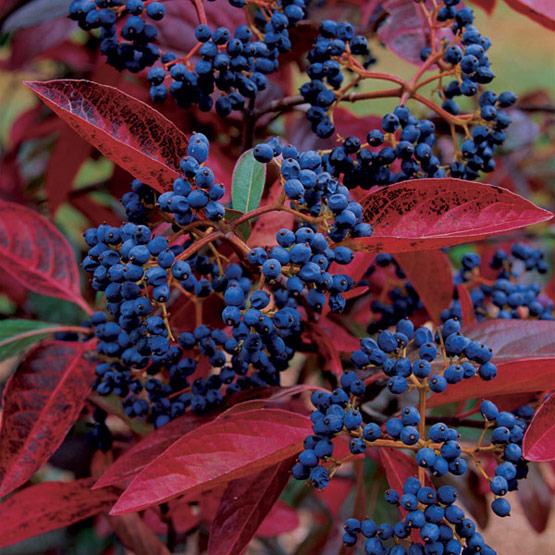
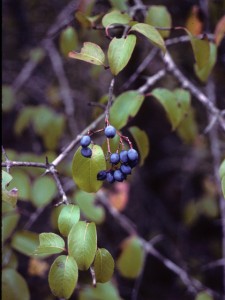
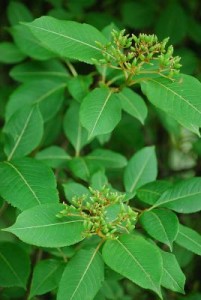
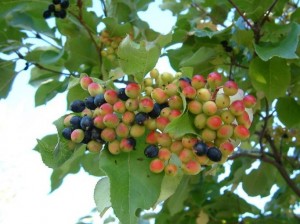
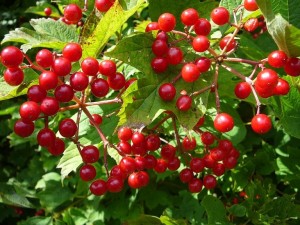
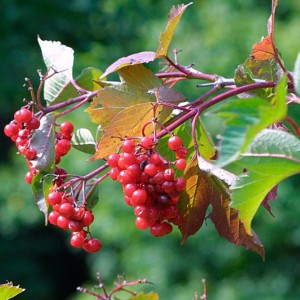
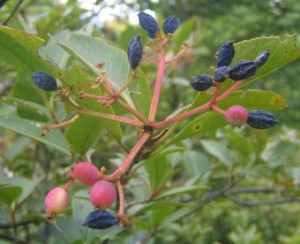

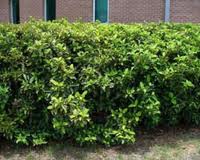
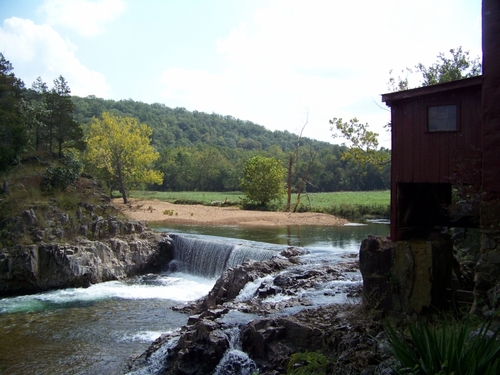

We are discovering all sorts of vibernums underneath years of garden neglect on the property that we inherited. I appreciate them as cold climate hardy shrubs (they must be hardy to survive the conditions here for over 20 years with no water) but now some of them are actually edible? That excites me more than it should! I just saved your information so that I can head off and check out all of the properties that you mentioned in this wonderful post and now my long suffering vibernums can have a haircut and can stay in my edible food forest garden legitimately without just being “bee attracting shrubs” 🙂
Trilobum was common in Indiana along the rivers we kayaked, and was also used as an ornamental at my college (where I’d snack on it, much to my peers’ horror). I’ve been hoping to find something similar in west central Florida, as I miss the ease of “edible foragables” identification. Here in FL, I’m still leery of eating a great many wildlings — I still can’t tell the proverbial toadstools from the mushrooms (and on a literal note, how I miss morel season!).
Beauty and Pleasure
Viburnum Opulas sits ornamentally in many gardens around the world without its full potential being recognised as a healing and edible plant.
When in bloom it stops onlookeers in their tracks. Beautifully shaped snow balls of flowers and subtle scent. Great for attracting beneficial insects as an ecological balance in an organic fruit and berry orchard.
Can one make tea from snowball flowers? (Opulus)
Hey Green Deane!
I was so elated to discover Black Haw (prunifolium) on my property…but now that I’m looking at this post….mine look more like lentago!
will have to take more pics and let you know…
Great blog by the way!!!
The national arboretum website said Koussa dogwoods have a melon tasting fruit. I have a dogwood that blooms a month later than native dogwoods (same time this harsh spring), and it has fruits that look like your pic of Koussa dogwoods EXCEPT the fruits stand up straight like a candle instead of hanging down. Also they are tasteless instead of tasting like melons. (And they may have made my head swim after putting 3 in mouth to try to get the melon flavor.) Can you enlighten me.
John – I’m no expert, but you should be able to send a twig with leaves, buds and maybe flowers or fruit to your state university for identification, to the department of horticulture. State forestry or departments of natural resources ususally deal only with natives.
That said – from your description I wonder if you may have a Pacific dogwood (Cornus nuttalli) which can appear to have a globe-shaped fruit, (actually a cluster of drupes), but instead of dangling down a few inches below the branches, it sits upright. Or maybe you have a hybrid between kousa and another dogwood?
By the way, the flavor of the fruit of the Cornus kousa is apparantly widely variable, as these trees have not been selected for their fruit… at least not here in America.
It would be interesting to hear what you are able to find out about your dogwood.
Enjoyed your blog about Viburnums. I am purchasing many Viburnum tirlobums cultivar Compactum or also known as Spring Bouquet. I live in Mexico and placing them around the outside of the house. My concern is for the children who might want to eat the fruit. Since this Viburnum is eatable does that mean that all the cultivars of this species is OK to eat as well?
Hello,
I have a Viburnum tree, several, in fact, growing on our property in Northern Michigan but I have not been able to identify them. The closest I have come is V. prunifolium because it has the shape of the fruit but the berries are a golden color before ripening and tart. They do have the big seed within. Any ideas? I have a picture of the leaves and berries.
Your blog looks great. I have bookmarked to study later.
Many thanks, Carol
are doublefile viburnum leaves edible (Maresei) can I use leaves in cooking or on a food plate as decoration? Thank you!
Suggest that Mr. Lerch try Cornus mas, Cornelian cherry
We are in SE Texas and have both Rusty and Arrowood viburnum on our ranch. The Rusty had much smaller bloom clusters followed by many of the fruit falling off. The Arrowood is just now blooming and the size and quality of bloom clusters seem more what we are accustomed to. We had an unusually cool spring nights. Is it reasonable to assume the”cool spring” may have created the smaller bloom clusters and dropping of fruit on the Rusty Blackhawk viburnums?
To my knowledge, no.
I went to a tree nursery to buy Highbush Cranberry (Viburnum trilobum) and they sold me Viburnum Sargentii instead. I only noticed the mistake after all five of them were planted. I called the nursery and they told me they are practically the same, except for the shape of the leaves. I wanted the Virburnum trilobum mostly because the fruits are edible (jellies) and because they attract birds. I was told the fruits taste the same and they both attract birds. However, I haven’t been able to find any information where it says that the V. Sargentii fruits are edible. I’m also concerned that birds may not eat non-native fruits. I live in New-Brunswick, Canada. Are V. Sargentii fruits edible for humans and will birds eat them as well? Thank you for your insight.
V. sargentii is not mentioned in any of my references regarding edibility.
I have a shady back slope yard. Thinking about planting some arrowwood vibernums under trees. Will they grow ok under shade. Are their berries ediable? What do they taste like?
Is the Viburnum Rufidulum toxic to goats? I noticed a couple in the pasture. At least I THINK that’s the species.
In looking to buy some Viburnum cassinoides, I keep seeing Viburnum nudum var. cassinoides in the online nurseries. Are they the same thing, or different? I want to get them going on a back fence line for both tea and berries.
Are the berries of VIBURNUM DENTATUM edible?
Yes, but there isn’t much to eat.
Do I need to spit out the seeds when I eat the berries? Or are the seeds safe to consume?
Th is art icle h as been do ne with the he lp of GSA Content Gen erator Demoversion.
No, it was researched in libraries by me and written by me, I generated all of the content.